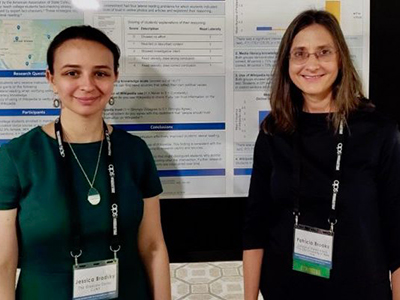Jessica E. Brodsky is a doctoral student in Educational Psychology at The Graduate Center, CUNY. Her dissertation research evaluates the impact of lateral reading instruction on undergraduate fact-checking skills. Patricia J. Brooks is Professor of Psychology at the College of Staten Island and The Graduate Center, CUNY. She is involved in WikiProject Women in Psychology and has engaged her students in editing Wikipedia since 2012.

Image courtesy Jessica Brodsky, all rights reserved.
The past two years have been difficult for students and faculty alike, as we have had to grapple simultaneously with the consequences of the COVID-19 pandemic and an information infodemic, defined by the World Health Organization as “an overabundance of information—some accurate and some not—that makes it hard for people to find trustworthy sources and reliable guidance when they need it.” As social media platforms and fact-checking organizations struggle to keep up with vetting COVID-19 related information, it has become urgent for all of us to learn effective strategies for deciding whether online information can be trusted.
Wikipedia can play an important role in helping students quickly determine if sources of information are trustworthy. For example, features of the National Vaccine Information Center (NVIC) website suggest that it may be a trustworthy source of information about vaccines: the website has a professional appearance, a “.org” domain name, and uses references in its articles. However, a quick search in Wikipedia reveals that the NVIC is an anti-vaccination advocacy group. In fact, professional fact-checkers often turn to Wikipedia as a starting point to investigate the potential biases or agenda of a source; see here for more information.
Over the past several years, we have partnered with colleagues teaching civics to first-year college students at the College of Staten Island, CUNY. As one of 11 institutions participating in the Digital Polarization Initiative (DPI) sponsored by the American Association of State Colleges and Universities, we have aimed to teach college students how to use lateral reading strategies to vet online information. Lateral reading involves leaving a website to investigate the people and organizations promoting the online content, finding out what other sources have to say about it, and tracing the content back to its original source. Lateral reading contrasts with vertical reading strategies often associated with checklists like the CRAAP test, where students are taught to scrutinize online content for specific features. Given the complexity of the internet today, vertical reading strategies have proven insufficient for accurate fact-checking. Initial findings from the DPI suggest that deliberate instruction in lateral reading improves college students’ fact-checking skills; for more details see here.
In Fall 2020, we shifted instruction to focus on information related to the COVID-19 pandemic and economic recovery efforts. As instruction was fully online, we built a series of asynchronous assignments to teach lateral reading skills. In our pretest assessments, we learned that using Wikipedia to investigate information sources went against what students had been taught before college or in other college courses. That is, 77.8% of students (N = 221) indicated that their teachers had discouraged them from using Wikipedia as an information source and 67.9% said they were unlikely or very unlikely to recommend Wikipedia as a source of information to one of their classmates.
Over the course of the semester, students completed three assignments where they practiced using Wikipedia to investigate the agenda of various information sources (people and/or organizations). All the assignments were tied to course themes and current events. For example, students used Wikipedia to learn more about the authors of tweets opposing mask mandates and to research an organization whose tweets expressed concerns about the United States’ economic recovery under President Biden.
At the end of the semester, not only were students more likely to read laterally when determining how much they trusted online information, they were also more likely to report using Wikipedia for academic and non-academic research and to recommend Wikipedia to others. Students were also more accurate in their knowledge about Wikipedia. When asked to select their first-choice strategy for evaluating the trustworthiness of a website, 42.9% indicated that they would use Wikipedia to learn more about it––a marked increase from 5.9% at pretest!
Adults today are clearly aware of the challenges of figuring out if they can trust COVID-19 information they see online. According to an April 2020 Pew Research Center survey, only 28% of adults felt very confident in their ability to determine the accuracy COVID-19-related news. Our students felt similarly unsure at the start of the semester, but made gains in their confidence in vetting COVID-19 related information. On the pretest, only 27.6% of students indicated confidence in their ability to fact-check online news about the COVID-19 pandemic; this proportion doubled (55.2%) at posttest. For more details about this project, and examples of assessments that you can tailor for their own courses, see here.
Image credit: Alex Irklievski, CC BY-SA 4.0, via Wikimedia Commons
